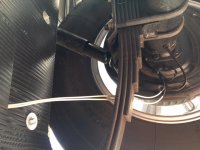mlpeloquin
Well-known member
Looks normal there. In fact a lot cleaner than mine was. How are the connections inside the connectors and are the contacts oxidized? Next would be to inspect the wiring at the brakes themselves for pinched wiring or cut insulation. You may want to follow the wiring down to the first break that it is connected to first. While under the rig you will find that the break wires actually go into the center of the axles. The openings are sharp and several have had intermittent shorts there. The solution was to cut and jumper the wire on the outside of the axles. As described above the problem could be pinched wires inside the break assemblies as well.
One more thing to add is to do as suggested and pull the break-away switch. You should hear the magnets hum. When pulling the switch it applies 100% of the battery voltage to them. So only do this for a short period of time as stated in the above post.
One more thing to add is to do as suggested and pull the break-away switch. You should hear the magnets hum. When pulling the switch it applies 100% of the battery voltage to them. So only do this for a short period of time as stated in the above post.

